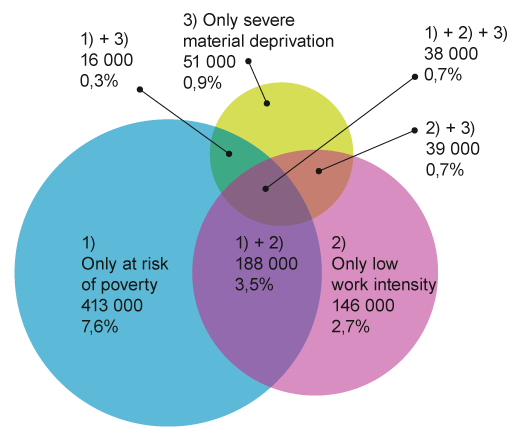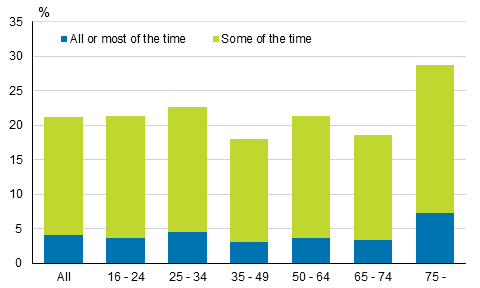Published: 24 May 2019
890,000 people were at risk of poverty or social exclusion in 2017
Statistics Finland's new statistics on living conditions shows that 890,000 Finns, or 16.4 per cent of the household population were at risk of poverty or social exclusion in 2017. Most of the people that are at risk of poverty or social exclusion live in low income households, which constituted 12.1 per cent of the population. Next to living in a low income household, having low work intensity is second most common, affecting 7.6 per cent of the population. Severe material deprivation is least common and applies to 2.6 per cent of the household population.
Persons at risk of poverty or social exclusion by dimensions of risk in 2017

Being at risk of poverty or social exclusion means that the person is living in a low income household, a household with low work intensity or a household that experiences severe material deprivation (see concepts ). One of these risks materialising means that the person is at risk of poverty or social exclusion, but the risks can also be simultaneous. There were 654,000 persons living in low income households, 410,000 persons with low work intensity and 143,000 living in severe material deprivation in 2017.
Most persons at risk of poverty or social exclusion are only members of low income households. They numbered 413,000 persons or 7.6 per cent of the population and slightly under one-half of all persons at risk of poverty or social exclusion. The second most common situation was to experience both low income and low work intensity, which affects around 188,000 persons or 3.5 per cent of the population. Mere low work intensity is the third most common, and that applies to approximately 146,000 persons, or 2.7 per cent of the population. More information about the risk of poverty or social exclusion can be found in database tables .
The so-called AROPE indicator (At Risk of Poverty or Social Exclusion) that measures the risk of poverty or social exclusion is part of the monitoring of the objective of the Europe 2020 Strategy. It aims to reduce the number of persons living at risk of poverty or social exclusion in the EU by 20 million by 2020 compared with 2008, when there were 116 million people at risk of poverty or social exclusion. In 2016, altogether 113 million persons were at risk in 28 EU countries.
The level of risk of poverty or social exclusion is clearly lower in Finland than in Europe on average. In the EU 28 approximately 22.4 per cent of the population were at risk of poverty or social exclusion in 2016 when the share in Finland was 15.7 per cent. Finland’s share is the third lowest among the EU countries. In Finland, the risk of poverty or social exclusion is through low income directed especially at young adults and persons aged over 75 for whom the risk of poverty or social exclusion is on the EU average level. Especially for children, people of working age and younger pensioners the risk is clearly below the EU average.
Loneliness burdens old people and persons living in single adult households most
In all, 4.0 per cent of the population aged 16 or older, that is, around 179,000 people, felt lonely all the time or most of the time in 2018. Altogether, 21.2 per cent or 950,000 Finns felt lonely all the time, most of the time, or some of the time. Those aged 75 or older were loneliest, as 7.3 per cent of them were lonely all the time or most of the time and around 28.7 per cent were lonely at least some of the time. Persons living alone felt lonely most often and, in addition, in single supporter households, the feeling of being lonely was more common than on average.
The Survey on Income and Living Conditions used as the basis of the statistics on living conditions asked in 2018 of persons aged 16 or over how often they had felt lonely in the past four weeks. The response alternatives were all the time, most of the time, some of the time, a little of the time and none of the time. More information on loneliness can be found in database tables .
Frequency of feeling lonely in the past four weeks by age in 2018

The statistics on living conditions also contains information on, e.g. health, subjective well-being and living conditions.
Statistics Finland has established a new statistic on living conditions starting from 2019. The statistics covers data collected with annual interviews in the Survey on Income and Living Conditions concerning households’ and their members’ living conditions, for example being at risk of poverty or social exclusion, subjective livelihood, health, subjective well-being and housing conditions. Data have been collected since 2003 for the European Survey on Income and Living Conditions EU-SILC coordinated by Eurostat and, so far, the data have only been available via Eurostat. The now released statistics also utilises national data, such as the classifications according to socio-economic group and households' life cycle. In addition to the statistics on living conditions, sample data for the annual income distribution statistics and the data for the statistics on households’ assets produced at set intervals are produced from the Survey on Income and Living Conditions.
The data content of the statistics on living conditions and the data published in the database tables will be developed and complemented in coming years, for example, with data from additional question modules carried out at set intervals. The micro-data on which the statistics are based, are available for research use subject to an authorised permission to use data both through Statistics Finland and Eurostat, and tabulation can be performed upon request based on separate assignments.
Source: Statistics on living conditions 2018, Statistics Finland
Inquiries: Kaisa-Mari Okkonen 029 551 3408
Director in charge: Jari Tarkoma
Publication in pdf-format (185.8 kB)
- Tables
-
Tables in databases
Pick the data you need into tables, view the data as graphs, or download the data for your use.
Updated 24.05.2019
Official Statistics of Finland (OSF):
Statistics on living conditions [e-publication].
2017. Helsinki: Statistics Finland [referred: 22.12.2025].
Access method: http://stat.fi/til/eot/2017/eot_2017_2019-05-24_tie_001_en.html

